|
July 2015 - September 2015 |
| |
|
|
 |
|
 |
| |
Publisher: Chairman Gong-Ru Lin Editors: Professor
Chao-Hsin Wu, Ms. Hsiao-wen Lin November 30, 2015 |
| |
|
| |
|
 |
|
~ 2015 GIPO Karaoke Contest Highlights
~
(May 25, 2015, at 1F small theater, Audiovisual Instruction Hall, College of Liberal Arts)
Composed by
Yu-Hsiang Su, the president of GIPO
Student Association
The 2015 GIPO Karaoke Contest has finally taken place. First of all, we would like to thank GIPO
chairman Gong-Ru Lin, for his kind presence and for sharing with us his interest in guitar and singing when he was a student. This year, we have 2 judges: NTU pop music singing club instructor
Chih-An Chen, who also performs at restaurants, and on the streets of Taipei; Hsin-Yi Liu, an instructor, who, in her senior high school years, had performed in a TV singing-contest show and placed 8th. These 2 professional judges gave encouragement and advice to all contestants, then after careful appraisal, selected the 3 winners. The rest of the contestants were given gift vouchers to reward for their excellent performance for GIPO students.
We had 15 performers, including individual
and team performers. They were allowed to bring
in their own guitars to play along on the stage.
Each performer showed his/her powerful, clear, spiritual, emotional, or sorrowful voices. Their singing was filled with so many wonderful emotions that everyone in the audience was greatly impressed. Friends and
classmates of the contestants also helped cheer on each performer, by putting encouragement scrolling text on their cell phones and loudly applauding at the end of each song.
During the 20-minute intermission, free snacks were provided at the courtyard of the theater. Students took this opportunity to chat about previous performances and encourage the students who were going to perform onstage later. The atmosphere at the scene was quite boisterous.
After all the performances, the 2 judges reached a common consensus through careful deliberation, and announced the 3 best performers. The judges say they were deeply touched by the enthusiasm of the contestants who participated in the contest while also taking care of their studies.
They said that they have enjoyed listening to each performance and wish this wonderful event could last forever. The 3rd place is Yen-Chang Chen, whose song is
"Thinking of You, Wishing You Well"; everyone enjoyed his simple voice accompanied by guitar. The 2nd place is
Chih-Keng Chu; his song is "Who Else Could I Love". His singing is powerful and emotional, completely revealing the song's soul and feeling.
And, the 1st place is the team of
Xue-Qian You and Ting-An Ku with their song "Rated Ours". Their duet
was a perfect harmony, and accompanied by the swift melody, made for an enjoyable and touching listening experience.
The rest of the contestants also contributed a great deal to this wonderful night; it would not have been so successful without their remarkable performances. At the end of the contest, some of the performers asked the judges for advice to improve their own techniques. The judges generously gave them encouragement, and brought the 2015 GIPO Karaoke Contest to a close. We would like to thank GIPO teachers and staff
members for your support and encouragement. Thanks also to our student audience; we hope that this event has helped in improving friendships among students of different laboratories. And, finally, we would also like to thank our student association friends and the 2 students from the classic guitar club, who generously provided the guitars. Thank you all for your help!
~ Highlights of the GIPO Optoelectronics Summer Camp, 2015
~
(July 21~23, 2015, at Barry Lam Hall, NTU)
Composed by
Yu-Hsiang Su, the president of GIPO Student Association
It's time for the GIPO Optoelectronics Summer Camp
again. This year, we had undergraduate students from several universities, most of whom majored in optoelectronics, electronic engineering, and physics related fields, join us. We also know of several students traveled from southern Taiwan to join our camp. Since you are working hard to grow through these summer months, we prepared thorough explanations of courses and experiments, to help you become more familiar with optoelectronics and know more about what your future could be.
At the very beginning of the 1st day, we had GIPO
chairman, Professor Gong-Ru Lin, give us an introduction to the history and development of the related fields in optoelectronics. During the following interaction session, students were grouped into 4 teams, which enabled them to get to know each other and their team-director, sharing their goals while taking part in this camp with team members, and trying to find friends who are close in interest and study with them. Moreover, students also took this opportunity to learn from team-directors, and other senior students, their reflections about life in graduate school. During this session, we have realized that students are mainly concerned about the semi-conductor field of study and graduate school entrance exams. It appears that they are keen on finding answers for these questions.
Next, Professor Jian-Jang Huang, the
vice
chairman of GIPO, gave us a lesson concerning the technology and industry of solid-state lighting. His lesson, emphasized in its application, introduced us to the most advanced characteristics and advantages of its devices.
Then
Professor Chao-Hsin Wu gave us a lesson concerning solar cell technologies. He also took us to the roof of Barry Lam Hall to visit a real solar cell module. During this visit, the enthusiasm from students asking questions was as hot as the noon sun.
After lunch
and a short break, we visited laboratories and
optoelectronics experiment drills. We visited a
few laboratories in the
EE-II Building
and received a brief introduction of the clean room, which allowed students to gain a deeper understanding of lab operations. Through experiment drills, students observed some simple optoelectronics experiments and a practical demonstration of a liquid crystal device. And, they also learned the basic laser interference principle and the making of hologram.
Students were very excited about the schedule on the second day, because we went to Hsinchu Science Park to explore the optoelectronics industry. First, we visited the headquarters of Epistar Corporation. They received us warmly. The manager of Employee Relationship and Human Resources gave a detailed introduction to Epistar's environment and its employee relationship. After the introduction, he has also sent an engineer to lead us to visit the assembly line and explain to us the manufacturing process and the testing of LEDs. During lunch, students chatted excitedly with Epistar's superintendents. Yu-Ting Wang, one of Epistar's managers, who had taken care of the GIPO summer camp before, also came to share with us her reflections about working at Epistar. She also talked about some challenges which Epistar is facing, and some strategies which the industry and individuals should adopt. We believe students learned a lot from her.
At the Industrial Technology Research Institute of Taiwan, R.O.C., we observed another aspect of top science research achievements. The most noticeable is the biomimicking tree in the showroom, which is a combination of solar cells, photocatalyst
air-cleaning devices, LED light guide plate, and
quality water circulation system etc. It's a
true reconstruction of plants' functions with
modern technology. Also, those advanced
technologies, such as the medical
instrument - portable retina digital video
camera, super energy-saved lamps etc., have
really amazed us all.
The 3rd day, Professor Jui-Che Tsai gave us a lesson concerning the multi-application of microelectromechanical systems. He has explained to us the profound theories in simple languages; from basic accelerometers, common MEMS, to scanners, he made us realize their many possible applications. Next,
Professor Hoang-Yan Lin gave us a lesson concerning the introduction of display technology. He let us do some hands-on drills, such as manual 3D holography pyramid and Google cardboard on cell phones, and watch a video which is perceived from different angles by each of one's
two eyes, and therefore produces a 3D image effect. The manual 3D holography pyramid had excellent visual effect, and
was interesting and easy to make; therefore, students liked it very much.
The last course is the introduction of the application of biophotonics
in industry, delivered by Professor Sheng-Lung Huang, who has recently been followed with interest by Taiwanese media for his new technology
"high
speed submicron 3D tomography for clinical use". Biophotonics is a new, hot field of optoelectronics.
Professor Huang used his own expertise to introduce to us various types of skin and eyes microscopy, which I believe would benefit us a lot.
After the last course, the GIPO chairman addressed the camp again, and certificates were conferred upon each student. The 2015
GIPO Optoelectronics Summer Camp thus came to a perfect end. Finally, we would like to thank all students for your keen interest.
|
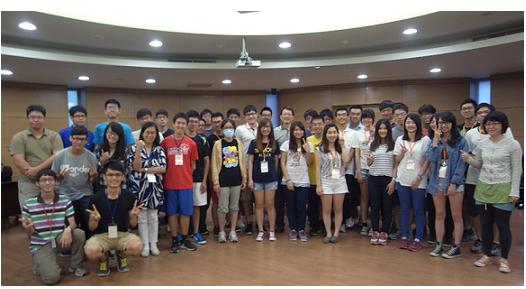 |
~ A self-introduction of the President of GIPO Student Association, 2015
academic year ~
Composed by
Yu-Ting Huang, the president of GIPO Student Association
 Hi, GIPO teachers and students, I'm Yu-Ting Huang, the
new president of the GIPO Student Association.
I'm very happy to be of service to you in this
coming year. First of all, I would like to thank
Ling-Yi Kuo, a student of Professor Hoang-Yan Lin's laboratory, for her recommendation which leads me to take this position. I would also like to thank the following former presidents of the GIPO
Student Association – Yi-Jiun Chen, Ting-Hao Chen and Yu-Hsiang Su – for all of your kind instructions. I hope I will fulfill your expectations and make our association and GIPO stronger. Hi, GIPO teachers and students, I'm Yu-Ting Huang, the
new president of the GIPO Student Association.
I'm very happy to be of service to you in this
coming year. First of all, I would like to thank
Ling-Yi Kuo, a student of Professor Hoang-Yan Lin's laboratory, for her recommendation which leads me to take this position. I would also like to thank the following former presidents of the GIPO
Student Association – Yi-Jiun Chen, Ting-Hao Chen and Yu-Hsiang Su – for all of your kind instructions. I hope I will fulfill your expectations and make our association and GIPO stronger.
The association's mission is to care for GIPO students, including pushing for students' rights, speaking for students, and sponsoring GIPO students' activities, which include a party in the 1st semester and a ball game, or a karaoke contest in the 2nd semester, like last year. However, junior students like us have not yet experienced any of those events. We can only base our preparations on paper records and instructions from senior students. Under such circumstances, events from each year are a bit different. However, I don't find such differences to be a bad thing; on the contrary, these differences encourage creativity. The style of each event depends on the special characteristics of each year's student association. Therefore, we need you to join us!
Usually, graduate students only make friends with those studying in the same laboratory. However, we believe it's a pity to not even know classmates in other laboratories during 2 years of graduate student life. I hope the association can be more than just a bridge between students and GIPO office, but also a bridge amongst students themselves. After all, we belong to the same field of study, meaning chances are high that we will meet again in the future after graduation. My ideal association is a big warm, happy family where everyone can find good friends, learn from each other, and give free rein to your talent, and it should be a wonderful memory in our lives. You are most welcome to join the association!
In fact, there are still many things which
could be done to improve the association;
therefore, we need you to join us to make it
more complete. I belong to Professor Chih-I Wu's laboratory; you are most welcome to write me at the association's mail box, should you have any fresh ideas, or drop by our laboratory for a chat. I can bake some snacks to entertain you! I would like to thank the ladies in the GIPO office for your assistance, and thank my
adviser for his support.
|
|
 |
|
 |
|
| |
|
 |
|
~ The 15th International Conference on Numerical Simulation of Optoelectronic Devices; NUSOD 2015 ~
(September 7~11, 2015, at Barry Lam Hall, NTU)
Composed by
Fei-Ping Weng
NUSOD 2015 was held on September 7~11, 2015, at Barry Lam Hall, NTU. In past years, NUSOD had been held at different countries around the world. This year, it was sponsored, and presided over, by Yuh-Renn Wu, an associate professor of GIPO, NTU, and Joachim Piprek, the chairman of NUSOD Institute. Scholars from Germany, Japan, Korea, India, China, Singapore, USA, Canada, UK, Ireland, Norway, Sweden, France, Poland and Australia attended this conference. They presented almost a hundred theses, revealing that they have been hard at work in studying the related subjects.
Professor Yuh-Renn Wu was committed and hardworking in preparing and directing all aspects of this event, including drafting, budgeting and setting up a website for this international conference held at NTU.
We would like to thank Professor C. C. (Chih-Chung)
Yang and his assistant Pei Chang for their kind experience-sharing in finding the conference site and handling several details, which enabled us to proceed with this event smoothly. Thank you to GIPO office staff Hsiao-Wen Lin for her direction in the application of inviting Mainland's professionals to enter Taiwan. Thanks to GIPO, EECS
and other office staff for their kind advice in
preparing meals, which our guests enjoyed.
Professor Yuh-Renn Wu insisted on good quality and healthy drinks; therefore, only superior ground coffee, and tea, was served at the conference. Thank you to GIPO office staff for their timely assistance in providing us with all necessary materials and answers for our inquiries. One week prior to the conference, some laboratory students joined us, pouring new energy into our team. Thanks to those 1st and 2nd year GIPO students for their concerted efforts in preparing and cleaning the conference site. In conclusion, during the meeting, everyone, from the time-keeper in the meeting room, to the garbage classification worker outside the meeting room, to the photographer in and out the meeting room, did their best, and made this event a great success.
Most impressive of all were the attending scholars. Whether they came from near or far, they plunged themselves into the research and discussion each session. There were always scholars coming to check in before 8
am. Every day, from the poster session on the 1st day, the rump session on the 2nd day, the banquet and visiting historic scenic spots on the 3rd day, the laboratory visits on the 4th day, or the workshop on the 5th day, was full and very educational.
We had warm sunshine and a delightful breeze during the precious half-day of our visit to the National Palace Museum and the Taipei 101 tower. At the museum, we felt like we had travelled through a time tunnel and were amazed by ancient civilizations. On the viewing platform of Taipei 101, we saw the whole of the Taipei basin, and the city itself. We also heard the whistling of the wind cutting through the railings of the platform. We walked through the air bridge and saw both the new and old parts of Taipei, glowing in the beautiful sunset. During dinner in the evening, all our guests talked merrily. As we left
the restaurant, we all felt wonderful and music on the street made our steps lively. We hope that this international event not only promoted academic exchanges, but also improved the relationship and understanding among foreigners and Taipei, Taiwan.
The 5-day long NUSOD 2015 came to a successful conclusion. We wish to thank all the attending scholars for your enthusiastic participation and exchanges. Thanks to GIPO and NUSOD Institute for sponsoring this conference. Thanks to IEEE, Institute of Electrical and Electronic Engineers, and the Ministry of Science and Technology, R.O.C., for co-sponsoring the conference. Thank you to the “Meet Taiwan” office of the Ministry of Economic Affairs, R.O.C., for sponsoring free maps and leaflets, which helped improve relationships among our guests and ourselves. Also thank you to participating manufacturers for your kind cooperation, and thanks to everyone on our team; together, we have completed a fantastic job!
|
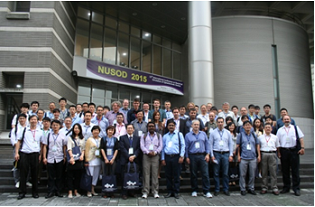 |
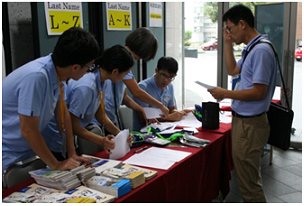 |
|
A group photo of all the participating scholars, on the 1st day |
Check-in counter |
|
 |
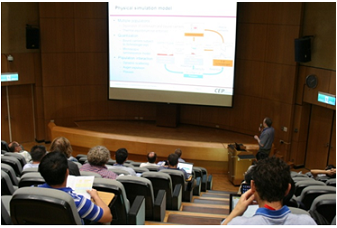 |
|
A gift package, from "Meet Taiwan", for foreign scholars |
Oral reports and idea exchanges |
|
 |
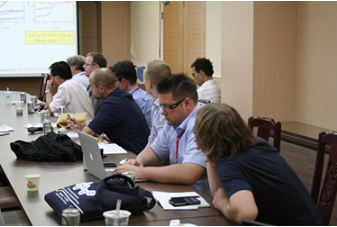 |
|
Poster Session |
Rump Session |
|
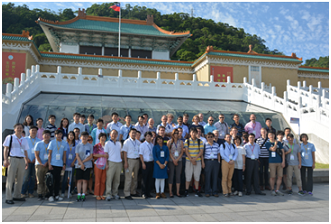 |
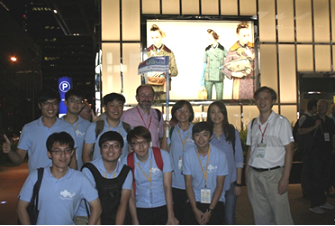 |
|
Visiting the National Palace Museum |
A group photo of our team |
|
|
 |
|
 |
|
| |
|
 |
Environmentally Benign Technology for White Lighting
Professor Ching-Fuh Lin
Graduate Institute of Photonics and
Optoelectronics, National Taiwan
University
White light-emitting diodes (WLEDs) have the great potential to make a tremendous impact on energy consumption throughout the world. Unfortunately, conventional WLEDs phosphors utilize expensive rare-earth elements (REEs) and the rare-earth mining, refining and disposal bring extremely high environmental cost. Therefore, the development of eco-friendly phosphors free of REEs and toxic metals has been one of the challenges for the next-generation light sources. Although quantum dots (QDs) and nanocrystals (NCs) have been considered as promising alternatives, the strong quantum confinement effect in these nanoscale materials causes their efficient excitation wavelength to be limited in UV region. This limitation severely impedes their integration with commercial blue LEDs to fabricate high luminous efficacy WLEDs.
Therefore, we use II-VI nanoparticle engineering to serve as an environmentally responsible strategy for white light generation. We successfully develop a novel technique to synthesize II-VI nanoparticles without quantum-confinement effect. Because the photo-physical behavior is not restricted by quantum confinement, the nanoparticles can exhibit a strong absorption at 453 nm, which well matches the wavelength of commercial blue-LEDs (450-460 nm). Also, the nanoparticles can efficiently convert blue light (440-460 nm) to orange light (580 nm). Integrating with commercial blue-LED (450 nm), the emission of both candle light and bright white light can be clearly observed (Figure 1).
Additionally, we integrate ZnO and ZnS:Mn semiconductor nanoparticles with polymeric materials poly(9,9-di-n- hexylfluorenyl-2,7-diyl). The resultant nanocomposites can be endowed with three different photon-generating mechanisms corresponding to blue, green and orange emssions, respectively. Consequently, white light can be produced and exhibits widely tunable color temperatures, ranging from 2100 K to 6000 K. As shown in Figure 2, the photoluminescence spectra and the image indicate that the emssion of the nanocomposites has very low color temperature, similiar to candle light, which is good for human health. A warm-white light emission with 90% high quantum efficiency (QE) has been demonstrated under the commercial UV-LED excitation.
The proposed nanotechnology-based materials can not merely serve as a judicious strategy to overcome the health issues involved in current blue-YAG-LED lighting, but also eliminate the use of REEs for environmentally friendly solid-state-lighting technology.
|
 |
|
Figure 1. Photoluminescence (PL) excitation and emission spectra of the prepared II-VI nanoparticles. |
|
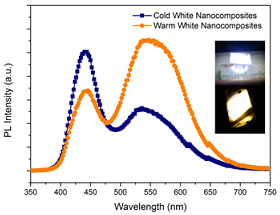 |
|
Figure 2. PL emission spectra of the cold white and warm white nanocomposites. |
Lateral Development Rate to Reduce Proximity Effect in e-Beam Lithography
Professor Chieh-Hsiung Kuan
Graduate Institute of Photonics and
Optoelectronics, National Taiwan
University
An ideal strategy for ebeam lithography is to apply the primary beam for exposure. The deposited energy on the resist by primary beam inside this narrow region is relatively extremely higher than the outside forward scattering and backscattering regions and causes a much larger solubility of resist (for positive tone resists). Therefore, the developing rate of resist in primary beam region is much higher than that in outside scattering regions. In this work, we propose a method based on rapid development to separate the primary beam region and electron scattering region and hence to effectively reduce the proximity effect.
Fig. 1 shows the doughnut patterns with various inner radiuses from 100nm to 1.5μm and fixed outer radius of 15μm that were exposed with various dose time from 0.5μs to 15μs. After developing for 5min to ensure complete development, if the resist at the center of pattern was just developed as a collapsed cone, the critical conditions of Ri and dose time were obtained. Fig. 2 shows the fitting curve and the results of EID. The EID displayed the distribution of electrons but not the distribution of electron energy. The high-energy primary beam electrons were integrated inside the forward scattering region and not revealed in EID profile. Fig. 3, the result of single spot experiment shows a rapid increment of hole diameter R in the first few seconds (region 1), and a transfer region (region 2), and finally achieve a steady and slow increment (region 3).
|
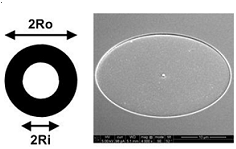 |
|
Fig. 1 The diagram and SEM image of doughnut pattern. The shadow region is the scanned region by electron beam. |
|
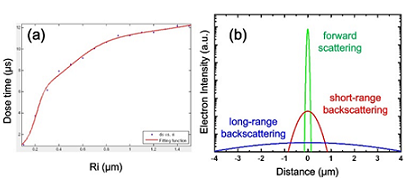 |
|
Fig. 2 (a) The result of doughnut experiment and the fitting curve of equation. (b) The fitting result of EID profile. |
|
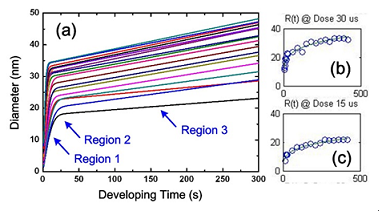 |
|
Fig. 3 (a) Fitting curves of the single spot experiment with dose time from 15μs to 100 μs. (b) and (c) are two examples of fitting. |
High two-dimensional electron mobility in a SiGe/strained Si/SiGe quantum well
Professor Chee Wee Liu
Graduate Institute of Photonics and
Optoelectronics, National Taiwan
University
The two-dimensional electron gas (2DEG) mobility has reached 2 × 106 cm2/V s at 0.3 K for 15 nm strained Si well with a 526 nm Si0.86Ge0.14 barrier layer. The SiGe/strained Si/SiGe heterostructure was grown on p-type (001)-oriented Si at 550℃ by hot-walled ultrahigh vacuum chemical vapor deposition. The factors that limit the mobility are the background charges, the threading dislocation density and the roughness at the Si/SiGe heterojunction. Reduction of Ge concentration in the SiGe barrier layer and the relaxed buffer layer that reduces the threading dislocation density and the roughness, effectively enhances the mobility of the 2DEG in the Si channel. The background doping was greatly reduced by high purity gases and the long-time baking of quartz tube.
|
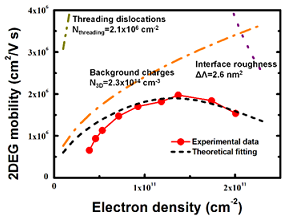 |
|
Figure
1. Electron density dependence of the 2DEG mobility for the sample with Si0.86Ge0.14 relaxed buffer layer measured at T = 0.3 K. The maximum value of 2DEG mobility of the Si0.86Ge0.14 sample reaches 2 × 106 cm2/V s at the electron density of 1.4 × 1011 cm-2. |
|
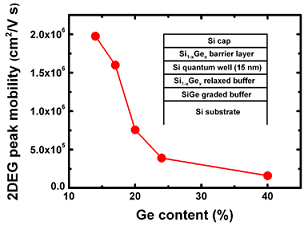 |
|
Figure
2. The 2DEG peak mobility as a function of Ge concentration in the relaxed buffer layer. The inset demonstrates the SiGe/Si/SiGe heterostructure schematically. |
Threshold voltage controlled by gate area and gate recess in inverted trapezoidal trigate AlGaN/GaN MOS-HEMTs with PEC and PEALD oxides
Professor Lung-Han Peng
Graduate Institute of Photonics and
Optoelectronics, National Taiwan
University
An enhancement-mode, AlGaN/GaN
inverted trapezoidal trigate MOS-HEMT wrapped with double-layered oxides, i.e., PEC-grown Ga2O3/(Al,Ga)2O3 and PE-ALD Al2O3, was demonstrated to exhibit positive Vth = 1.2V with current on/off ratio of 108 and sub-threshold swing of 160mV/dec. HRTEM analysis revealed trapezoid-shape channel sidewalls due to crystallographic wet chemical etching by using molten KOH, and a reaction rate-limited process at which the outer surfaces of the nonpolar/semipolar GaN facets are converted into crystalline α-Ga2O3 passivation layers with preferential growth of (003) α-Ga2O3 upon the c-plane of GaN. From DC characteristics analysis of diverse gate recess depths and different gate areas of fabricated devices, we suspected that there is negative polarization in the interface of double-layer gate oxide and barrier to compensate the strong polarization charge induced by AlGaN/GaN heterostructure, and hence, to lead to higher threshold voltage than other HEMTs without gate oxide. These observations can be ascribed to combined effects of (a) interfacial negative space charge of 3.2 μC/cm2 in the gate-recessed device to partially compensate the spontaneous charge, and (b) side-wall passivation to preserve the high mobility channel. It relaxes the constraint of using nanometer scale channel width to achieve positive value of Vth and results in a cut-off frequency of unity current gain/power gain at fT/fmax = 9/36GHz at gate length/width of LG /Lw = 250 /360nm.
|
 |
|
Fig. 1 (a) Top-view SEM micrograph of inverted trapezoidal trigate AlGaN/GaN MOS-HEMT with gate recess, (b) 3D structural diagram of this device, (c) the fT and fMAX plot corresponding to LG=250nm E-mode AlGaN/GaN inverted trapezoidal trigate MOS-HEMT, and DC measurements for (d) IDS-VDS family curves, (e) transfer characteristics and transconductance curve in linear-scale, (f) transfer characteristics of IDS-VG in log-scale and IG-VG gate leakage current measured in a three-terminal configuration. |
Ref: Po-Chun Yeh, Yun-Wei Lin, Yue-Lin
Huang, Jui-Hung Hung, Bo-Ren Lin, Lucas Yang,
Cheng-Han Wu, Tzu-Kuan Wu, Chao-Hsin Wu, and
Lung-Han Peng," Threshold voltage controlled by
gate area and gate recess in inverted
trapezoidal trigate AlGaN/GaN MOS
high-electron-mobility transistors with
photoenhanced chemical and plasma-enhanced
atomic layer deposition oxides", Applied Physics
Express, 8, 084101, 2015.
Broadly tunable and low-threshold Cr4+YAG crystal fiber laser
Professor Sheng-Lung Huang's Laboratory
Graduate Institute of Photonics and
Optoelectronics, National Taiwan
University
Broadband fiber lasers and amplifiers in the 1.3–1.6 μm wavelength regime, providing extra bandwidth beyond that of the erbium-doped fiber amplifier, could be the key components in future high-capacity telecommunication system. We demonstrate a Cr4+:YAG crystal fiber laser tunable from 1353 to 1509 nm using a birefringent filter and with a threshold pump power of 70 mW operating at room temperature. It was found that spherical aberration contributed more of the intra-cavity insertion loss of the glass-clad crystal fiber than chromatic aberration. The pump polarization was aligned with a crystal axis to optimize the fiber gain. The advantages of the crystal fiber include the reduced pump threshold due to the light confinement and the better thermal dissipation due to the high surface-area-to-volume ratio. The temperature rise of the crystal fiber with a 400-mW incident pump power was only 1.7 °C using passive cooling. This low-threshold crystal fiber laser is suitable for the application as a tunable seed source for the power amplifier chain.
|
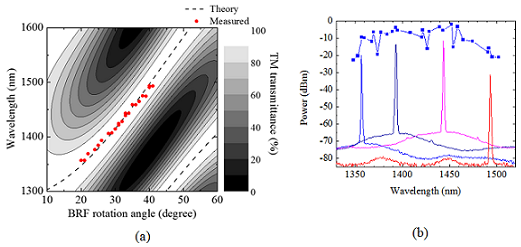 |
|
Figure: Results of the tunable Cr4+:YAG crystal fiber laser with birefringent filter (BRF). (a) Lasing wavelengths vs. the rotation angle of the BRF. Dashed line: Theoretical tuning curves of the BRF. Dots: Measured laser wavelengths. Background contours: Single-pass TM transmittance of the BRF. (b) Dots: The laser output power vs. laser output wavelengths under 400-mW pump power. Lines: four example spectra lasing at 1357, 1393, 1443, and 1494 nm. |
|
|
|
 |
|
 |
|
| |
|
|
 |
|
 |
|
|
|